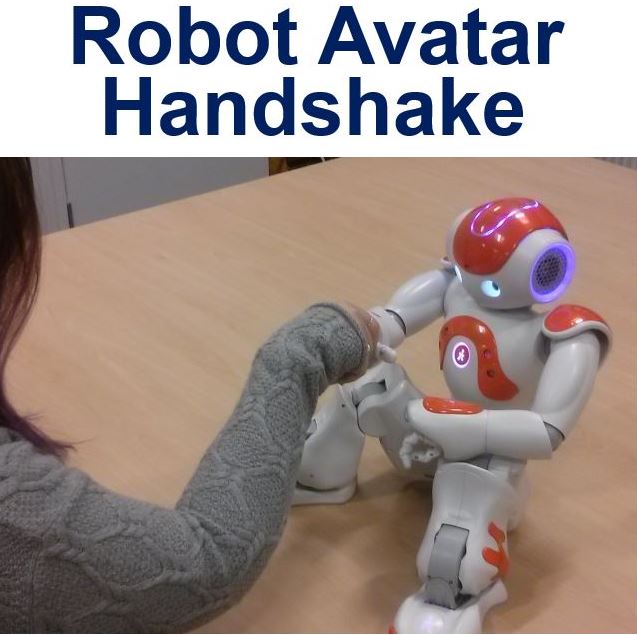Shaking hands is a vital component for successful business negotiations, even if the handshake is done through a humanoid robot avatar called NAO, researchers from the University of Bath in England reported.
A research team at the University’s Department of Psychology said we already know that the act of shaking hands when a business talk begins creates better trust and a desire to cooperate.
A study has now demonstrated that these benefits exist even if a robot is there, acting on behalf of a human – who could be sitting thousands of miles away – during a business meeting.

Shaking hands with NAO during a mock negotiation. (Image: delivery.acm.org)
Robot-avatar more effective than Skype
Using a robot avatar provides a powerful two-way experience that allows two interacting people to have a physical presence in a faraway place, which is not possible with video-conferencing or a Skype-like service.
Developing such interactions through your avatar could eventually lead to robots conducting these meetings, or allowing individuals with mobility problems being able to interact with the world in an extremely effective and unique way.
The study used NAO (pronounced ‘now’), a 58-cm (23-inch) tall autonomous, programmable humanoid robot developed by Paris-based Aldebaran Robotics, which came onto the public market in 2008.
NAO robots are especially popular in academic institutions for research purposes. More than 5,000 NAO units are currently in use in more than fifty countries.
Mock real estate negotiations with a robot
Dr. Chris Bevan and Professor Danaë Stanton Fraser used NAO in simulated real estate negotiations.
One participant – pretending to be either the seller or buyer – arrived at the meeting and was presented with NAO, while the other individual participated in the business meeting through the robot’s inbuilt microphone and head camera, i.e. NAO was their avatar.
NAO knows how to shake hands, and when it does a device in the remote person’s hand vibrates. This occurs because the robot has touch sensitive sensors in its hands which transmit a signal when it is grasped.
Dr. Bevan, Prof. Stanton Fraser and colleagues found that the simple act of shaking hands was as important when people negotiated virtually through the robot as when they physically met face-to-face.
The person interacting through their robot-avatar, who could be sitting several thousands of miles away, did not exploit their tactical advantage in such circumstances, the researchers found.

Study set-up. (Image: delivery.acm.org)
Handshake crucial for building trust and cooperation
Dr. Bevan, a Research Associate in the Department of Psychology, who is currently attached to the EPSRC (Engineering and Physical Sciences Research Counci) funded project ‘Being There: Humans and Robots in Public Spaces’ (2013-2016), said:
“This experiment highlights just how important the symbolic ritual of shaking hands is upon the way people come to judge others as being trustworthy and willing to cooperate.”
“Using a robotic avatar, we were able to demonstrate that this effect holds true even when a person cannot see the face of their counterpart.”
The researchers concentrated on how handshaking affected several levels of trustworthiness and cooperation, as well as the business participant’s willingness to be deliberately deceived.
Simulated negotiations were set up with 120 participants, each meeting involving two negotiators who were randomly selected to be either the seller or buyer, in a property buy-sell scenario. They pretended to negotiate deals worth between $38 million and $66 million (£24 million and £42 million).
One person interacted through their NAO-avatar. The remote person shook hands with a human through his or her robot, even though the two humans were far away from each other.
A sense of physical connection and proximity was created when the human in the meeting shook and touched the robot’s hand, while the avatar-user felt the vibration during the handshake.
Prof. Stanton Fraser, who works in Human Computer Interaction and leads the University’s CREATE Lab, which conducts research into the design and evaluation of mobile and ubiquitous technologies, said:
“The formation of interpersonal trust and cooperation are key to future success of computer supported cooperative work, yet the availability of many of the social cues we rely upon when interacting one-to-one are often restricted in these scenarios.”
“These findings underline the significance of touch and the simple gesture of a handshake, and will be important as we work to further develop robot systems with valuable applications across society.”
In each mock negotiation, one participant performed his or her role through a computer using a robot-avatar (NAO). They were able to see and hear the other participants through NAO, but were not physically present in the meeting room.
The human who was physically present in the meeting room interacted with NAO, and could hear the other human through NAO’s built-in speakers. However, he or she could not see the other person.
The team carried out several types of mock negotiations – with handshake, without handshake, and with or without vibrations to the person not physically present.
An international team of scientists created an 8-foot tall robot called ‘Dextrous Blue’ that can take the boredom out of mundane household chores. It can fold and sort clothes.
Citation: “Shaking Hands and Cooperation in Tele-present Human-Robot Negotiation,” Chris Bevan and Danaë Stanton Fraser. HRI ’15 Proceedings of the Tenth Annual ACM/IEEE International Conference on Human-Robot Interaction. Pages 247-254. ISBN: 978-1-4503-2883-8. DOI: 10.1145/2696454.2696490.
Video – NAO the robot
Aldebaran Robotics CEO and founder Bruno Maisonnier demonstrates the latest version of the NAO humanoid robot.

